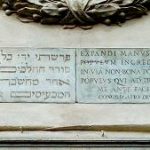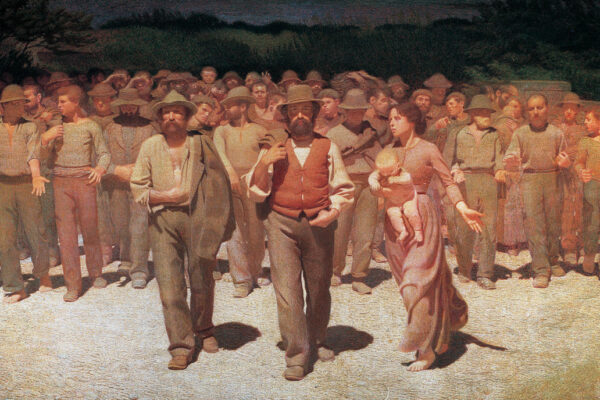Jews and the Present of the Past: A Retrospective Look at the the ‘Symbolic and Ethnic Other’
Manuela Consonni (Hebrew University) introduces Kenneth Stow (University of Haifa)
Starting in the late 1980s, Shoah memory begins to flow through texts as social, political and cultural catalysts that describe a crucial and peculiar illusion of our era. After the collapse of the Soviet Union and the ensuing reorganization of European internal politics, began a slow process of disintegration of the traditional political identities. Ethnic identities, melancholic and mostly aggressive, were their substitutes. I believe that this reorganization of Europe had a tremendous impact on the place of the Jews in the historical memory of World War II.
The new European Heimat has forged a memory policy that perpetuates the principle of symbolic ethnicity in the memory system of the Shoah. It is a memory that possesses a universal concreteness of identity to a greater degree than do other events, due to its relatively large number of witnesses. Thus, it transformed the identitary concept of specific groups into an identitary concept loaded with universal values. At the same time it produced an estrangement of the Jews from the European space. European collective memory tends to have moved from a patriotic, anti-fascist and national memory of the Resistance, to a particular, vague memory of the Jews, from a memory of inclusion to a memory of exclusion.
The historian Kenneth Stow sustains that this interplay along the axis of history always existed: the Jews always belonged and did not belong at the same time. They were integral, but they were also a threat that had to be distanced from the body of the faithful. The Shoah as an historical event broke the largely unspoken pact that sustained the equilibrium between these two poles. And it is reflected precisely on the level of the memory.
The interplay between inclusion and exclusion stopped working. As long as heroism, political choice and ideology made up the principle and contents of commemoration, the Jews could not be its exclusive or its main focus, even if they held the place of anti-fascist martyrdom par excellence. The self-image of liberated countries like Italy, France – and Germany, in its own way – required first and foremost an active negation of collaboration in the deportations and extermination of the Jews.
As a consequence, the genocide of the Jews became primary means through which one considers the Nazi occupation, around which an alternative historical narrative has been built. I would like to argue that this modality sees in the Jews an ethnic specificity. This has, paradoxically, resulted from an absolute and hypertrophic memory of the Jewish extermination: in a process that I evaluate as ambivalent, the memory of the Shoah is nurtured by the rebirth of ethnic identities in which the Jews are still held, albeit virtually, as internal strangers. I call this the hypertrophic surfeit of memory – of the Jews of the Shoah. This actually started in the late eighties, and was related to the fact that, as a group, the Jews had largely ceased to exist in Europe in the form in which they were present before World War II (1). In today’s European perception the Jews exist mainly via Auschwitz, although their physical absence has not obviated the cultural need for their abstract presence in the European self-image. (2)
Europeans, today, like “dead Jews” – namely the Jews as passive victims, the ones who are punished for not being members of the majority that forms the corpus politicum (with corpus to be taken literally). It happened visibly, in my opinion, with the end of the Soviet Union. After War World II, this line that defined the orientation of many other symbolic lines in the ordering of European space was erased. The recognition of the past as linked to the deportation and the extermination of the Jews has arisen from a need for identity in the present. Because of its traumatic origins this linking provides stabilizing criteria for the social and political context (3). The quality of the atrocity blocked comprehension and fragmented memory, producing long-term effects that influence the way in which the past was and is represented (4). The reversal of collective memory during this period reveals the increasing impoverishment of identity. The fear of losing a defined identity translates into an ideological quest for identity, as granted by the natural political order. The demand for secure cognitive frames is reflected in the search for pure belonging inside borders; it entails looking for a potential stranger to return meaning to the anomic crisis of the group and its personal identities. One perceives the newly born national differences as decreed by borders that were not to be discussed, borders based not on convention and mutual agreement but on boundaries deemed to be natural.
M.C.: Looking retrospectively at the history of the Jews of Rome, can you contextualize the dialectic of inclusion/exclusion?
K.S.: The experience of the Shoah, seen within the context of what I deem the unique Roman Jewish existence, illustrates the difficulty Europe has had in defining itself in other than Christian terms. The problem really exists in the United States, too, but nobody dares say it, and this is not the place to discuss it. Putatively, the French Revolution ushered in the era of a secular corpus reipublicae politicum, but large elements in France refused to recognize this structural revolution, and these same people were confused, if not angered, by the concept of corpus. The political Corpus was, had been, and rightly should continue to be that of Christ, the Corpus Christi. Louis XVI and Marie-Antoinette were depicted as crucified, not executed.
Yet all of this was hidden, or more properly pushed to the sides, as states were achieving a pragmatic secularism, of the kind, for instance, that allowed Jews to die in WWI for both the Kaiser and the Western Powers, and to do so out of fervent patriotic feeling.
This was, in my estimation, only a brief respite, an intrusion of the abnormal. Even Mussolini instructed Gentile his education minister to restore classes in religion in the public schools in 1922. At stake here is not the simple question of religious belief or prominence. That issue could have been overcome. At stake was the fear that Jews were now set loose upon society after the ghetto was opened: Pius IX saw them as dogs barking (latrare) through the streets, as though let out of the kennel, using a most traditional image at that, gave them freedom to contaminate. But what? – the purity of Christian society, a concept sufficiently amorphous and indefinable to make its invocation all the more threatening. Jews wanted, one bishop said in 1885, “to kill Christianity itself.”
The Nazis were saying the same thing, if in totally different terms. Ostensibly, the Church had every reason to oppose the Nazis—they did pervert traditional religious concepts—although it was always more fearful of the communists. This could explain why Pius XII chose to remain silent.
But I think there is something more. One medieval Jewish chronicler was very specific. If somebody sought to pursue the Corpus Christi perversely, for instance in pursuing Jews under the guise of pursuing the Grail, then the Jews had one address. A difficult one, for it was also the font of restriction, but a safe one, nonetheless. The popes. In this chronicle, known as the terrible event of 1007, the Jews approach the pope, who sends a legate to quell a persecution, which the legate does successfully.
This was in the Middle Ages, however. Then, there was “an agreement to disagree,” even into the thirteenth century, when the 1007 was written. The Christian world was one, and disputes of rulers and popes were not over doctrine, but power, or money. The Jewish anomaly could be tolerated. But when, later, these disputes became doctrinal, everything changed. The corpus mysticum Christi, the Church, sought out radical solutions. Jews would live within a ghetto, and a policy of conversion would be consistently followed; this had not happened before. As the Church felt even greater challenge from modernity in the eighteenth century, its policies became more stringent yet, including virtual kidnappings.
At the same time, the policy was carried out in the context of strict legal observance, oxymoronic as it may sound. Jews were also being forced ever more to live by ius commune, the common law of the land. This may sound beneficial, and it would be in a state with no state religion, even if it meant, and it did, that Jews had to give up their own self-governance. However, the continued existence of a state religion showed, to the contrary, that if Europe was to maintain its traditional moorings: the popes are historically, if indefensibly, right to insist the word Christian be included in the European Constitution—then it could not give up traditional identities.
As long as, in Rome, at least, this drama was played out in the Papal State, the leadership (if not the Jews were being led, often by the nose) could remain confident, oblivious, even, to the inherent contradiction of legal absorption and uniformity, even while the medieval definitions of citizenship based on religion remained in force. When the ghetto era ended, the deck of cards had been reshuffled.
Returning, as it were, to the status quo ante-the ghetto era, the old, distinctly medieval, equilibrium of “present but unequal” was was impossible. Hence, if living with Jews created problems that had never before existed, there were reasons to listen to what the Nazis and other political anti-Semites were saying.
The Shoah, just because it offered a radical solution to one of Europe’s fundamental conundrums and suggested a way to solve it, had to have fallen on some attentive ears. Had not Benedict XIV in 1751 wondered even then whether the monk Rudolph was right to preach Jewish destruction in 1751.
If Pius XII remained silent, regardless of how many Jewish lives he actually saved, one may wonder whether there was not a certain confusion in the Church as it confronted modernity. The medieval pope had no problem. He knew being Jewish was wrong, and he may have suspected Jews of the worst. But he also knew where to say stop, and when that stop was needed. Some of the more radically clergy did not want this, but they were put in their place, even after 1475 at Trent. By 1900, this was no longer the case. The silence of Pius XII was preceded by that of Leo XIII, who refused to publish papal statements—already made, hundreds of years earlier—denouncing ritual murder accusations. In Leo’s day, this was too dangerous. The real defenders of the Church and its unity (the corpus mysticum Christi were the Jesuits publishing new libels on a weekly basis in La civilta` cattolica. Ironically, the Jews’ defenders were also Jesuits, in Antwerp, the Bollandist researchers of Saints Lives. But they were liberals, who exchanged ideas and pupils with Jewish savants in Paris. This was gravely threatening, and the Antwerp Jesuits soon found their writings censored.
The ghetto, it turns out, had provided an ideal solution—for the popes. Jews were neatly controlled. But the modern world totally rejected such an extreme. Faced with a Jewish minority beyond its control in the post-Ghetto era, the popes could continue their policy of caritas. Both St. Augustine and the ninth-century Bishop and Saint Agobard of Lyon had recommended that, regardless of how much suspicion both harbored about Jews. But the exigencies of the mid-twentieth century, would accept nothing so transparently degrading. On the other hand, one could practice caritas, secretly hiding refugees, but also remain silent.
As for the Jews, they seem to have buried the worst of the ghetto era. They have remembered that they were—to some they still are—the Pope’s Jews; they are Roman’s after all, among the most ancient, and the papacy is a most Roman institution, or at least it has been till recent times. Their memory, too, is of the bull Sicut iudaeis non that made protection transparent. The Shoah they remember as an aberration. It should not have happened. In that sense, however much they recognize saints are an internal ecclesiastic matter, and however much the whole concept of Catholic sainthood, like all the other issues, concerns, and practices of Catholism are supposed to be foreign to them—the rites of others—with one issue they cannot make peace. On and after October 13, 1943, the pope deserted his traditional role, and to canonize this pope is also, for the Jews, to say that the traditional papal Jewish equilibrium is gone forever.
Rome’s Jews have something even greater at stake. If the old is truly a dead letter, what has replaced it? Until 1870, the vast majority of Rome’s Jews were comfortable with their dual Roman and Jewish identity. After 1870, they were told they were Italians. What about being Jews? To be comfortable with both identities is a struggle that is still going on, and the results are anything but clear.
Notes
1. Kurlansky, A chosen few : the resurrection of European Jewry, Reading, Mass. : Addison-Wesley, 1995
2. P. Nora, L’ère de la commémoration, in Les lieux de mémoire, III, Paris 1992, p. 1009; A. Wieviorka, L’ère du témoin, Paris 1998; Y. Tamir, The Quest for Identity, in Integration and Identity. Challenges to Europe and Israel, Bonn 1999, pp. 9-26; M. Salvati, Il Novecento, in ’900. I tempi della storia, Roma 1997, pp. 3-27; Id., La memoria e le cose, in La memoria e le cose, numero monografi co di «Parolechiave», 9 (1995), pp. 17-27.
3. L. Langer, Holocaust Testimonies: The Ruins of Memory, New Haven 1991; Id., Preempting the Holocaust, New Haven 1998; C. Caruth,
Trauma: Exploration in Memory, Baltimore 1995; Id., Unclaimed Experience:Trauma, Narrative and History, Baltimore 1996; Sh. Felman, D. Laub, Testimony: Crisis of Witnessing in Literature, Psychoanalysis and History, New York 1992. See also D. LaCapra su storia e trauma: Representing the Holocaust. History, Theory and Trauma, Ithaca-London 1994; Writing History, Writing Trauma, Baltimore 2001; . P.V. Mengaldo, La vendetta è il racconto, Torino 2007, p. 18. Dietz Bering, “Kulturelles Gedächtnis”, in N. Pethes, J. Ruchatz, a cura, Gedächtnis und Erinnerung. Ein interdisziplinäres Lexikon, Reinbek bei Hamburg, Rowohlt, 2001, pp. 329-332
M. Halbwachs, La mémoire collective, Paris 1968 ; P. Jedlowski, Memoria, esperienza e modernità, Milano 1989; J. Assmann,
4. La memoria culturale. Scrittura, ricordo e identità politica nelle grandi civiltà antiche, Torino 1997; A. Assmann, Ricordare. Forme e mutamenti della memoria culturale, Bologna 2002; P. Ricoeur, La memoria, la storia, l’oblio, Milano 2003; A. Foa, Rifl essione. Conferenza tenuta in occasione della Giornata della Memoria, Roma 2003 [inedito].









